A few years ago, I stumbled upon the Saucony Triumph and immediately fell in love with it for long runs. Since then, I’ve tested each new iteration and found that I like them all. The Saucony Triumph 22 has some changes, which may turn off some who loved older models…but I’m still in.
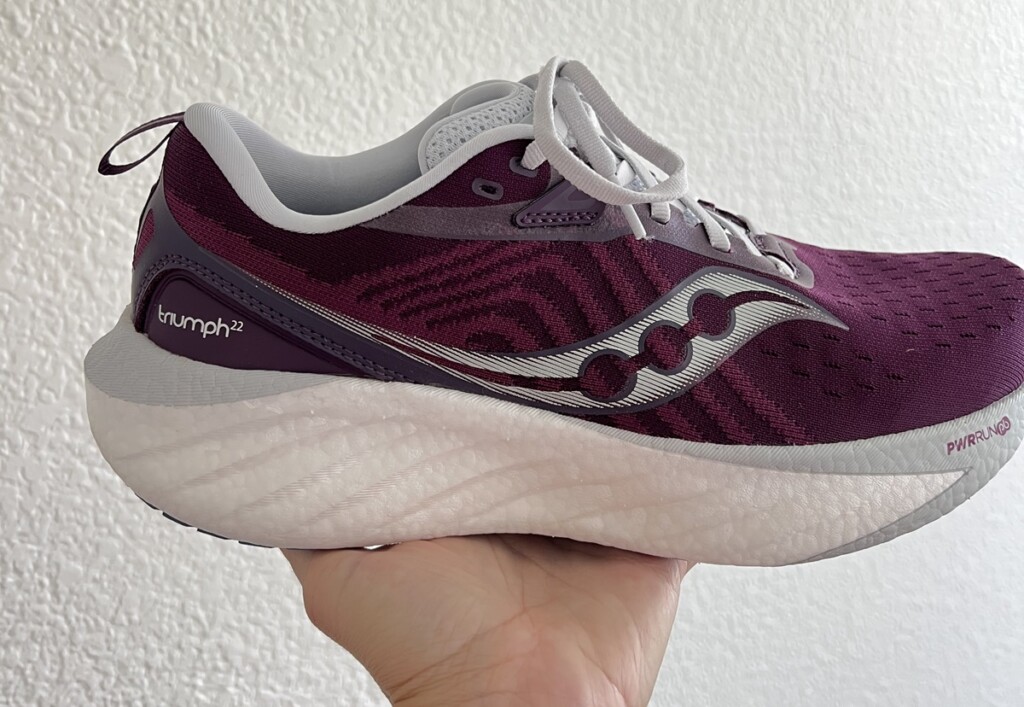 Not everyone needs or wants a max cushioned running shoe, but I can’t lie…they feel so darn good underfoot it’s hard not to fall in love. That’s why it quickly made my list of the best cushioned running shoes.
Not everyone needs or wants a max cushioned running shoe, but I can’t lie…they feel so darn good underfoot it’s hard not to fall in love. That’s why it quickly made my list of the best cushioned running shoes.
One of of the most notable changes in this version is the extended heel. We’ll talk more about this and overall fit, plus a comparison to older models below.
As always, you’ll get my honest feedback from using the shoe over multiple runs. And of course, there is no one perfect running shoe for everyone! So the goal here is to give you enough information to find out if this is what you’ve been looking for before you spend that moolah.
Saucony Triumph 22 Review
Admittedly I often test a shoe before actually reading any of the tech spec sheets that I’m provided. And in this case, I put the shoe on and knew it felt a bit different from the 21. I’ve put in enough miles on those to go through 2 pairs, so I’m quite happily familiar with this shoe.
What’s new? They switched from their standard PWRRUN foam, to their super trainer PWRRUNPB™ foam. You might remember me talking about it in the Saucony Endorphin Pro 4 Review, yup a carbon plate shoe.
Don’t get too excited, this shoe does NOT feel bouncy like the Pro, but still remains a max cushioned option.
Instead of making the shoe softer, I’d say it now feels a smidge firmer upon first instep. But after a few miles and then coming back to the shoe on repeated runs, it almost felt more broken in and thus softer. Strange because running shoes don’t really need to be broken in now, but that was exactly how it seemed.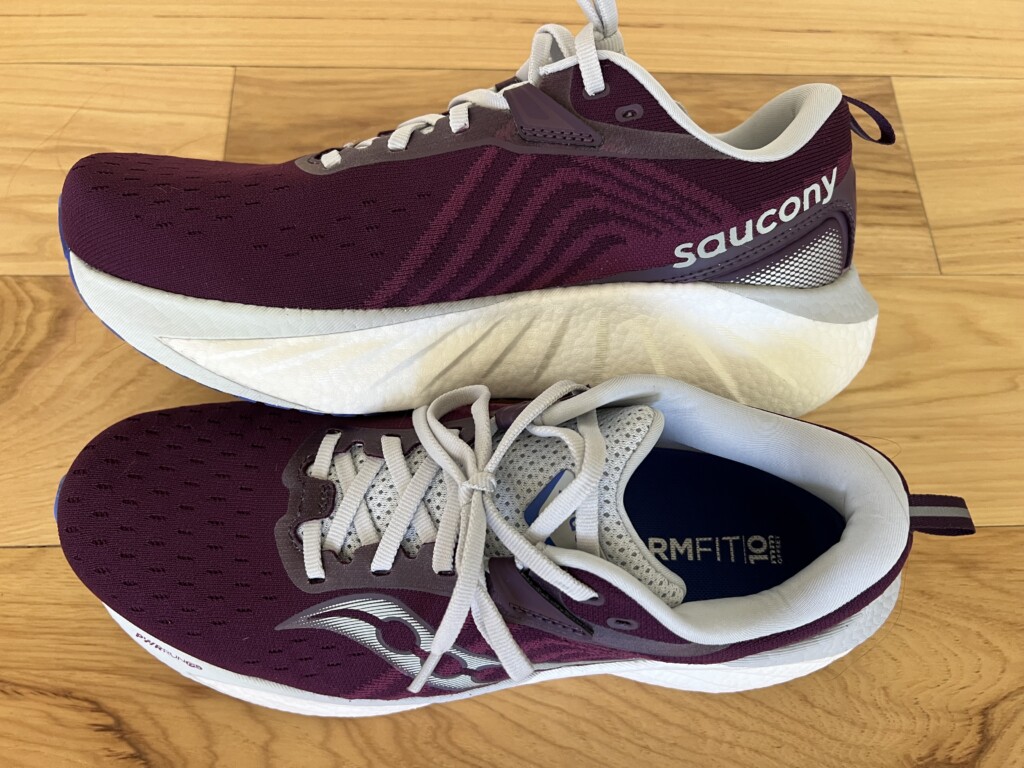
As I often do, I put both shoes on side by side to compare the feel.
Where the 21 may have become too soft for some runners and lacked the foot support, I think that’s corrected in the 22. Of course, that also means it doesn’t feel as soft and not everyone is going to be a fan of this.
The Saucony Triumph 22 is still a good choice for runners who are looking for a nice cushioned, stable feeling daily trainer that can handle marathon mileage. I’d happily wear this again on a variety of easy run distances.
Specifications
Let’s dive in with some of the top line info that we all need to know about a shoe! To be clear it’s not a FIRM shoe, just not as soft as previous models and it almost runs like a stability shoe now. You’ll notice this just looking down at your feet and seeing the whole base and heel is wider.
- Neutral shoe
- Moderate cushion
- Weight: 10.1 oz men’s, 8.8 oz women’s
- Heel drop: 10 mm
- 10colors
- Available in wide
- Available now on Saucony.com $160
- The 21 is marked down right now…snag it!
The stack height remained the same on this one, so it was mostly about swapping the type of foam being utilized and then making some changes to the upper and the heel.
Quick Take
Some highs and lows as we have with all shoes!
Pros
- Max cushion with their top of the line cushion
- Wider fit than other Saucony shoes
- Better stability than many max cushioned trainers
Cons
- It’s a lot of stack height to not be a plush cushion
- Not a lot of traction for wet runs or trails (it’s not a trail shoe)
- 10mm heel drop could be too high for those who often deal with IT Band issues
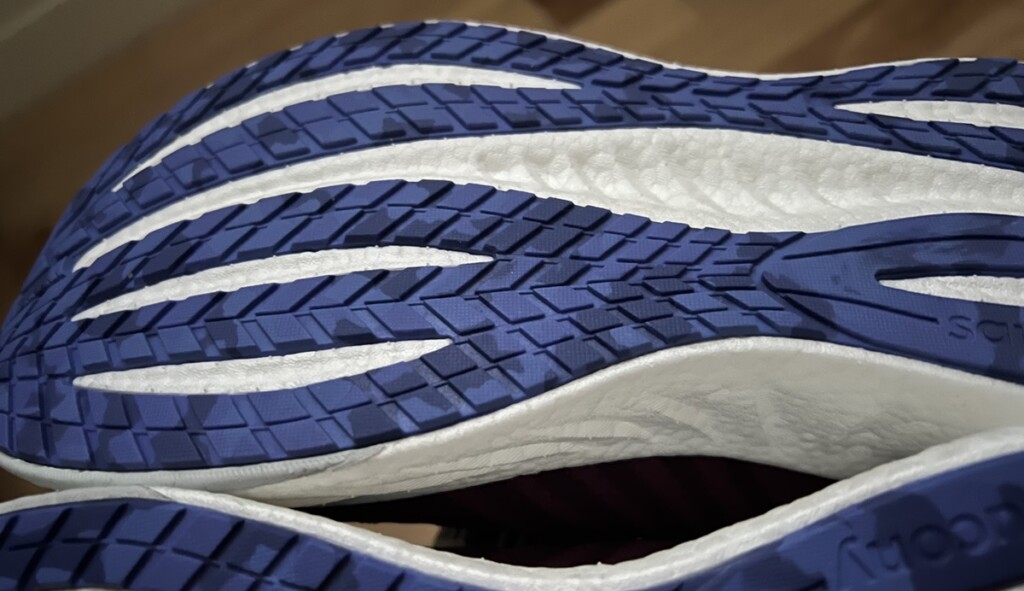
Who is it Good For?
Who is the Saucony Triumph a good fit for, let’s break it down by some common categories:
- Wide Feet: Opt for the Wide version of the shoe
- Heavier Runners: Great for good cushion and stability over longer runs
- Long Runs: Will work well for marathon runs
- Front of the Pack: It’s definitely not a race day shoe, could be a nice recovery day option
Saucony Triumph 22 Fit
In years past, I would describe some Saucony shoes like the Kinvara as having a more narrow fit; I would not say that for the Triumph. In fact, the in 22 they made some changes to create a little more width in the midfoot.
Not only does that create space, but allows the shoe to feel more stable overall. That’s a bonus as stack heights keep increasing in our quest for ever more cushion.
I wore my normal size, but I will say if you have a wide foot go for the wide simply due to the thick padded tongue and heel collar taking up space in the shoe. Both are comfortable, but sizeable and do nothing to help the shoe feel light or breathable.
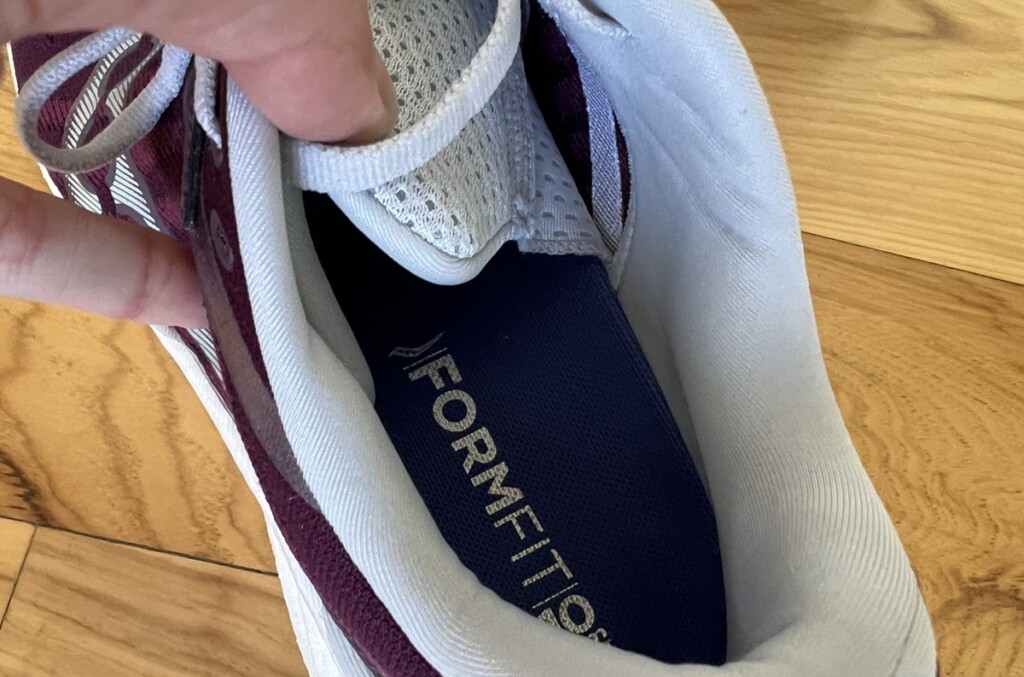
As noted the heel extends visibly on this shoe now, which is an intention design that HOKA has used for years to add stability as stack heights increase. I didn’t really notice it while running.
Saucony Triumph Goretex
Since it’s not unusual to need to get in some runs in the rain, we sent Coach Alison out with the updated Goretex model to let us know how it held up.
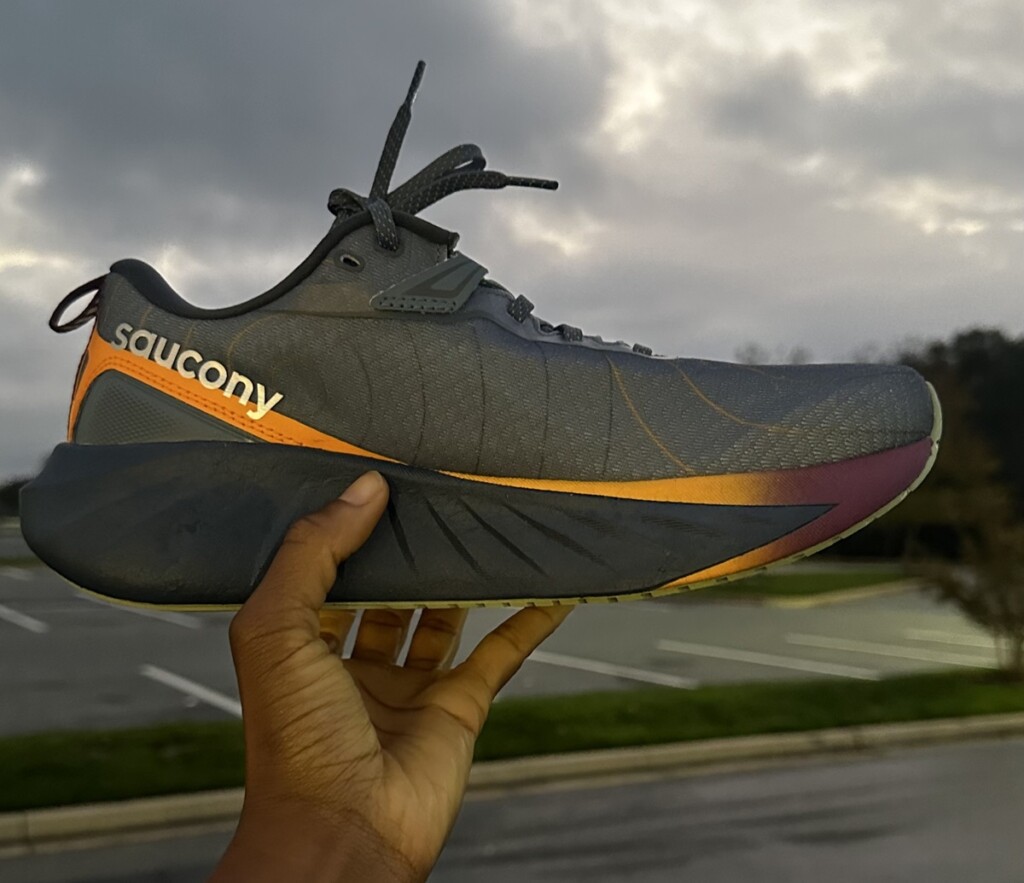
“I found the traction to be a little inconsistent.I wore these shoes on a 10 mile morning run, with brief periods of drizzle after a heavy rain. The roads and curbs were already saturated and I found my feet slightly slipping on both surfaces, intermittently throughout the run.
However, when the shoe did provide traction, it reminded me of a less aggressive trail shoe.
The shoes are very easy to clean and wipe off, water and dirt literally repel off the shoe as you run. The only evidence I had of rain on my run, was a few droplets on the outer surface of the shoe, and very very wet clothing.
Saucony Triumph 22 vs Triumph 21
For me the big question is always how does it compare to the recent model that many of you are familiar with (and that I have run a lot of miles in myself!).
This remains a shoe I’m going to recommend a lot of runners…but I admit to already looking forward to the 23 with hopes that some things will change back to the 20 and 21.
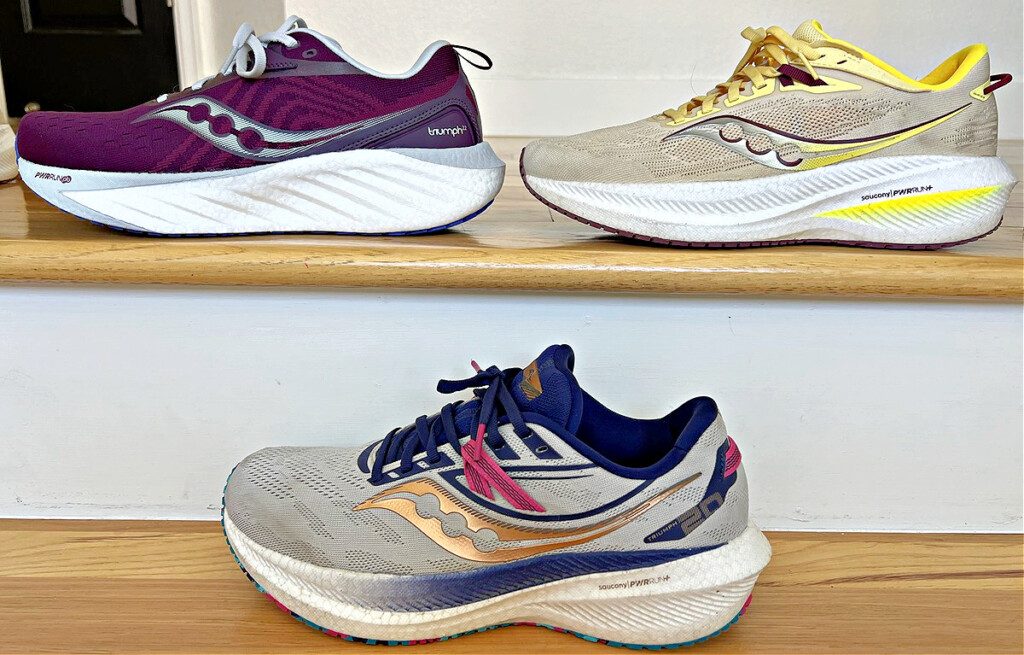
I’ve noted many of the changes above, but a quick run down:
- 22 is slightly heavier
- 22 has a wider midfoot and extended heel creating more stability
- Tongue and collar are slightly more padded
- Changed the foam for more energy return (though this is in no way a speed shoe)
I believe they had the idea of trying to create a super trainer like the On Cloudmonster Hyper.
But so far both brands are failing in this area. While we do want a shoe that’s going to help our legs conserve energy and get the benefits of the foam, the shoes are starting to feel like they’ve lost their way.
Saucony Triumph vs Saucony Ride
Both the Triumph and Ride from Saucony are considered neutral trainers, but they are definitely different shoes. Depending on your foot type and running style, one shoe may be a better fit for you than the other.
If you already know that you want MORE cushion then the Triumph is going to be your neutral shoe of choice. Of the three, it’s the shoe that I recommend most for long distance runners.
Those who are focused on shorter runs, even up to 10 miles are going to be just fine in the Ride. It’s also much more like the running shoes that many of us started out wearing in the early 2000’s. So if your body has done well with that, no need to change!
- Ride is an 8mm drop and now the lighter shoe!
- Triumph is 10mm drop with more cushion.
- Triumph may now provide a little more stability
- Ride has a slightly lower stack height (slightly less cushion)
All right, I really hope this Saucony Triumph 22 review helped you in making a decision! I may not love every single shoe that I test, but I’ve found that just sharing the details helps you find a shoe that YOU LOVE.
And that’s all that actually matters.
Checkout my complete breakdown of the best Saucony running shoes >>
Looking for other running shoe reviews??
- Saucony vs HOKA
- Saucony Endorphin Shift 3 Review
- How to Tell if Running Shoes Fit Properly
- How Long do Running Shoes Last
Other ways to connect with Amanda
Instagram Daily Fun: RunToTheFinish
Facebook Community Chatter: RunToTheFinish
Sign Up to Receive a Weekly Newsletter with Top Running Tips and Laughs



 Best Sunscreen for Runners + How to Pick the Right One
Best Sunscreen for Runners + How to Pick the Right One

I loved the Trumph for long runs when I was following half-marathon training programs and the long runs where all done at easy, steady pace (and looking back, they were not that long). Now that I’m following marathon training programs I find that the long runs are fast-finish long runs, and sometimes with also marathon-paced blocks in the middle. So for these runs the Triumph doesn’t feel good anymore, it feels heavy. So the Triumph is reduced to those easy weekly runs when I used to use the Ride, and now I have no room for the Ride. I used to use the Ride for the weekly easy runs, and the Triumph for the long runs. Now I have switched to the Endorphin Speed for long runs. Those 18-milers with 2 faster blocks and a fast finish on the Truth are not fun.